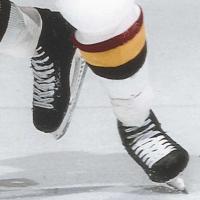Slate
Blackcurrant
Watermelon
Strawberry
Orange
Banana
Apple
Emerald
Chocolate
Marble
Slate
Blackcurrant
Watermelon
Strawberry
Orange
Banana
Apple
Emerald
Chocolate
Marble
-
Content Count
2807 -
Joined
-
Last visited
-
Days Won
93 -
Feedback
0%
Content Type
Profiles
Forums
Downloads
Gallery
Store
MSH News and Articles
Everything posted by flip12
-
D.Roy was in Makos for a long time, until now. Some guys that had them have switched back out. Personal preference as always, but I still get excited when I see someone new in VH.
-

The "revolutionary" channel Z skate sharpening by Prosharp
flip12 replied to Ivan's topic in Ice Hockey Equipment
I hope it's ok to revive an this thread. I have some questions about Channel Z as I'm considering it instead of FBV, which appears to be incredibly difficult to find in Europe. I skated on FBV twice and loved everything except how much I was grabbing the ice with stopping and pivoting manoeuvres. I'd be happy just finding which FBV suits me, but the only place I've found online that has FBV is a place in Hamburg, and I suspect I may like even less edge than they're going to be offering. 1. Most Channel Z sharpening for hockey appears to be adding the (small, medium, or large) channel to an otherwise standard ROH cut, is this correct? 2. Unlike the FBV, which has a flat between the diagonal edges, Channel Z can be done to skates with that but Pro Sharp only seems to recommend a "flat" middle for bandy skates. How similar is Channel Z's flat grind to an FBV grind? 3. Overall, Channel Z feels similar to FBV in terms of glide and edge grip (both of which were amazing in my FBV sessions) with their normal radiused and channeled sharpening? There's at least one place nearby in Malmo that does it, but I haven't been able to get a hold of them on more specifics about which options are available, and being an addicted MSH'er, I'm anxious to do my research before going in any one direction on it. Thanks for any help! :) Edit: forgot 1.A: How does a small, medium, or large channel differ in its effect on edge and flat feeling from the blade? -
I've noticed a couple-three pairs in the KHL, but now, Max Afinogenov:
-
Bauer already kind of did that with the one90, but didn't they just go back up to their higher cut boots? That's just their thing. Easton/VH will have to take a bigger bite out of Bauer's dominant market share for Bauer to think about doing anything to take back what they lose. I could be wrong, but that's been my projection of Bauer's stance on this trend.
-
Really impressed with the fit so far. First pair of skates I can say that about since my One90's. In case you haven't seen it yet, there's a huge thread on VH in here. It's a good read :)
-
Also Jets, Trouba, Stuart, and Peluso. Just spotted Cody Eakin with Dallas. Kulikov still wearing VH, has been since late last season. I think it's new with Hannan. Pictures I've seen show him in Nexus last year.
-
Sorry, I didn't mean to just throw it out there without clarification. VH stands for Scott Van Horne's company VH Footwear. There's a huge thread on here about the whole history of his current production line, but the short story is Scott's a former Canadian national team speed skater who started making speed skates about 20-years ago and has been making hockey skates for a little over 5 years: first under DASC, which became MLX, which got bought buy Easton and became the Mako, and now VH makes their own skates a lot like the MLX, with some variations made to that design. I'm a huge fan of classic Graf attributes (in a lot but not all of their old skates): lower cut boots, more foot-wrap and much more anatomical fit (for my feet), longer steel, aggressive pitch. I'll finally get to skate in MLX boots once my pair clears customs here, but from what I've gathered, they have a lot more in common with those attributes I like about Graf than they do with other skates on the market, but with newer technology and an extremely thermoformable boot. A few links: VH Footwear thread on here, which has links to VH Footwear's site. MLX thread, which died a horrible death due to seriously sad marketing practices from within MLX. All in all, I'm thrilled about the speedskate's incursion on the hockey market.
-
Also VH in Winnipeg, not knocking your choice in Graf though. Other than VH, I'm an admitted Graf kool-aid drinker.
-
Good to know on your follow up. Love the detail of your posts AfftonDad.
-
Is there a difference in the steel weight? How reduced is the set on your Makos?
-
Not really, if you follow his reasoning. He's thinking out loud about different production cycles of the same version of a particular skate model, where a batch of Mako I is not in the same set as a batch of Mako II: he is just comparing batches of Mako I to other batches of Mako I, and batches of Mako II to other batches of Mako II. Since MLX were not made by the same people in the same facilities, and also vary significantly materially from the Mako I, they aren't even the same product.
-
I agree, it could make a good team look. For me, it's just been a matter of circumstance--way too old royal blue helmet, red Eagle gloves because they were too good of a price to pass up, purple socks because that was my teams' colors (high school and college intramural), black pants and then whatever color jersey I have on for pick up usually completes the look. Unfortunately (or...?), I don't have any pictures of me in that setup, but you get the idea.
-
That would be perfect with my usual skittles look, each piece a different color.
-
I saw one person's custom measurements, and if I saw correctly, there are two for volume: around the instep and around the widest part of the forefoot.
-
Yes, I think Mako and Vapor both have 9' radius. Isn't Bauer doing something with 10' now too? I just found that with my Cobra holders and Graf's stock steel, which I think is an 11' radius, my skating was much better. I didn't feel I lost quickness on the longer edge and now that I know what radiusing does I'd maybe try something even longer, but with the background in roller hockey first, it makes sense to me why a longer radius can feel much better: we're used to working foot quickness without the help of a smaller arc to swish through stride by stride.
-
My experience going from roller to ice was the opposite to what you're expecting here. I had Cobra holders, with a long radius (11' I think) and aggressive pitch, and that made going from ice to roller much smoother for me. It's the radius (9' still feels too short for me) that felt strange compared to being on 4 wheels. Now I can't go back to stock Tuuk pitch or radius without noticing a lot of skips in my contact with the ice. You may like the CXN more than you're assuming now.
-
Good to know, but I kinda figured that would be the case.
-
That's an interesting point. Cruikshank + Van Horne had a much more notched angle on the top eyelets of the prototype boot shown in various history of the Mako videos. It looks like MLX and VH both have more of that L-shape, like the Vapor...also, are Makos higher cut than VH? IIRC, they don't specify what other skates participants wear in the study, just that they use their normal skates for half of the trial and Makos for the other half.
-
They actually find that the skaters have less sagittal (front to back) movement in Mako skates. They anticipated to find the opposite, but they suggest that it's due to the better fit and softer boot allowing a more natural foot/body position. They don't really discuss differences in angle due to the holder and runner. It would be interesting to see that normalized.
-
Me too. I'm happy with Easton's broader lie 5 offerings now, E4 used to be all, but now I can choose from 28, 36, 3...so sweet for me.
-
It's easy to forget. It's the weirdest feeling to skate on steel that's not fully sharpened into proper edges yet.
-
How much has the new steel been sharpened? A lot of people had difficulty getting the new Mako steel to hold its first edge, as it seemed to require more priming than other steels. It could just be that effect all over again, as I imagine that's been left untouched.
-
Mission ice hockey is essentially gone though, much to the sadness and disappointment to the many big fans of their skates--though they did manage to go the wrong direction after the hit of the S series.
-
My experience is similar--used to skate in an 11 Graf, now I'm down to 10 because I know how skates should fit better, how much the boot will stretch and also my Haglund's deformities are half the thickness they used to be. But I love the stability and quickness I had on that 296 Cobra. I played roller hockey before ice so maybe that's why more steel feels good to me all around, but it does nonetheless. I just have a hard time thinking of geometry as a marketing gimmick, especially when it involves more mass to be carried by the user. Granted, this obsession with light skates has gotten even hotter since the one90, but there were other things one could then call gimmicky about the skate just because Bauer's users didn't support it, the shorter cut boot on the one90 for instance. I would also resist calling that gimmicky, again for geometric reasons and on the basis of my experience.
-
How do runner lengths compare from holder to holder? I thought I read on here that Cobra holders have longer steel for their base length than Tuuk, etc.

